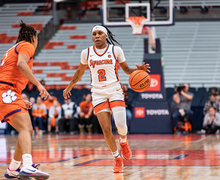How Onondaga County will count 57,000 absentee ballots
Corey Henry | Senior Staff Photographer
Forty bipartisan board of elections inspectors and employees will count ballots in Onondaga County.
The Daily Orange is a nonprofit newsroom that receives no funding from Syracuse University. Consider donating today to support our mission.
The Onondaga County Board of Elections will begin counting over 57,400 absentee ballots on Tuesday, which will potentially decide the outcome of several local races.
The county planned to begin counting on Nov. 9, until multiple candidates, including Rep. John Katko (R-Camillus) of New York’s 24th Congressional District, filed lawsuits for greater oversight of the counting process. As a result, the board of elections will delay the counting by one day.
Onondaga County had received 57,407 ballots out of 68,468 applications as of Friday, according to the county board of elections.
As the county prepares to count mail-in ballots, here’s a breakdown on what the process will look like:
Who is counting ballots, and what are they doing to prepare?
Forty bipartisan board of elections inspectors and employees will count ballots in Onondaga County, said Dustin Czarny, the county’s Democratic board of elections commissioner. He and Michele Sardo, the Republican commissioner, will oversee the counting.
New York state law mandates that every board of elections have a Republican and Democratic commissioner.
To prepare, the staff is currently organizing the ballots that have come in and looking for any problems with provisional ballots, Czarny said. Voters receive a provisional ballot if a polling place questions their eligibility to vote, then the provisional ballots are later counted if officials verify the voter’s eligibility.
What happens if a ballot has an issue?
If there’s a problem with a ballot, it will go through a cure process, Czarny said. This process entails sending a letter to the voter notifying them of the issue and allowing them seven days to mail back their corrected ballot.
The county has already found 800 ballots with problems that it has sent back to voters, Czarny said. Of those 800 ballots, voters have returned 500 to the board of elections, he said.
How are ballots counted, and how many will be counted per day?
After staff members sort the ballots, they will run them through high-power scanners. The results from those ballots will then be combined with the Election Day and early voting results to get the total number of votes.
The scanners can count about 8,000 ballots an hour, but the by-hand sorting from staff members could drag out the process by several days, Czarny said. The board will count ballots from 9 a.m. to 4 p.m. each day and is hoping to complete between 8,000 and 10,000 ballots per day.
“We’re gonna have several days of counting ahead of us,” Czarny said.

Sarah Jimenez Miles | Design Editor
Are there any concerns about voter fraud?
President Donald Trump and other Republican politicians have alleged, without evidence, that mail-in voting could result in voter fraud.
Czarny said voter fraud claims like Trump’s are baseless and damaging to voters’ trust in the electoral process.
“I’m always concerned about conspiracies, because at the end of the day, they tend to act in a way that’s oppressive,” Czarny said. “People don’t think their vote counts, and so they decide not to vote, and that’s really what their (conspiracies) intended to do.”
Katko, Sen. Rachel May (D-Syracuse) and Angi Renna, a Republican candidate for New York’s 50th Senate District, filed lawsuits demanding greater oversight of the counting process for mail-in votes.
Renna’s campaign was demanding a large volume of documents that would have caused a one- or two-week delay in counting the absentee ballots, Czarny said. The resolution to delay counting by one day allowed the campaign to review the documents in person over the weekend before the board of election could begin counting, he said.
Katko declared victory over his challenger, Democrat Dana Balter, after polls closed on Election Day, although Balter has yet to concede the race.
The three-term incumbent was leading Balter by about 20 percentage points as of Tuesday night. Katko earned 155,830 votes after all ballots cast in-person on Election Day and during the early voting period were counted. Balter received 100,728 votes.
The number of ballots that Democrats returned would likely not surpass Katko’s existing lead over Balter.
Czarny said Katko’s lead does not impact the way the board counts ballots, especially since they still have to account for other local races.
“We count every ballot every year,” Czarny said.
When will we have the final results?
Czarny is unsure when the counting will be completed. The goal is to finish within a week, but he can’t guarantee that, he said.
“This is the first time we’ve done it in such large quantities,” Czarny said. “No estimate on when it’ll be done. (But) I would love to get done within seven days.”
Published on November 8, 2020 at 10:00 pm
Contact Sarah: [email protected] | @sarahalessan





